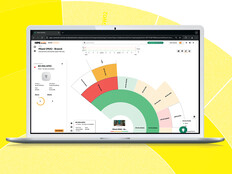Financial services companies aren’t immune to the impacts of remote and hybrid work. According to Fortune, one study shows that half of banks now use a hybrid model, while 18 percent are fully remote or let employees choose when they come into the office.
And while this operational approach offers benefits for both staff morale and bank profitability, it also comes with security concerns. Secure access service edge frameworks can help financial firms enhance network protection without compromising the user experience.
What is SASE and How Does it Provide Security Solutions?
SASE combines software-defined wide area networking (SD-WAN) with zero-trust security solutions. It does so using a converged, cloud-based platform that connects users, systems and endpoints to the applications and services they need.
In practice, SASE shifts the focus of security and connection from the data center to end users and their devices, effectively inverting the traditional security paradigm. By prioritizing the security of connected technologies, including user-owned mobile devices, company-issued technology and Internet of Things devices at the edge, banks are better equipped to detect and defend against attacks.
SASE solutions share four common traits. First, they are identity-driven; access is granted based on the identity of users and devices. They are also cloud-native, with both infrastructure and security delivered through the cloud. Third, SASE technologies are globally distributed. Finally, they support all physical, digital and logical edges, making it possible for users to work securely anytime, anywhere.
FIND OUT: What banks need to know about cloud platforms.
What’s Really Driving the Adoption of SASE in Finance?
The convergence of SD-WAN and SASE makes it possible for banks to create a holistic security model. Beyond the benefits of reducing complexity with combined solutions, there are three additional drivers of SASE adoption: compliance, cost reduction and the end-user experience.
With a focus on end-user device management, SASE allows financial firms to adjust security postures and processes in response to new regulations. By eliminating solution overlap with a combined security model, meanwhile, banks can reduce the total cost of their security solutions. Finally, a cloud-driven approach to device management means a better experience for end users no matter where or how they choose to work.
How Can Banks Navigate the Expanding SASE Market?
SASE combines multiple products to help banks create a consistent security framework. As a result, it’s not uncommon for SASE deployments to include anywhere from five to 10 products from multiple vendors. To help navigate this growing market, financial firms benefit from partnerships with experienced solution architects who can help them compare and contrast providers and the technologies offered.
While SASE deployments vary by organization, most include the following features:
- Firewalls
- Intrusion detection systems
- Cloud access security brokers
- SD-WAN
- Endpoint protection
- “Single pane of glass” management
LEARN MORE: How to boost cybersecurity with automation tools and careful planning.
What Are the Most Important Benefits of SASE for Financial Services?
This combination of networking and security offers three key benefits for financial services firms:
- Reduced complexity. In a SASE model, it’s possible to eliminate legacy security solutions and replace them with a single cloud-delivered model. This both reduces operational complexity and provides increased visibility across critical network operations.
- Improved agility. Because SASE solutions are managed using a single console framework, IT teams can make changes to policies or procedures in real time.
- Enhanced user experience. The cloud-based nature of SASE creates a seamless experience for users. Instead of navigating multiple solutions, each with its own requirements based on how and where users connected, SASE provides consistency regardless of location or device.
SD-WAN networks aren’t going anywhere, but the flexible nature of hybrid and remote work requires a new approach to security.
By shifting the focus from data centers to end-user devices, SASE offers a more sophisticated way to identify emerging threats, ensure regulatory compliance and reduce total risk.
This article is part of BizTech's EquITy blog series. Please join the discussion on X (formerly Twitter) by using the #FinanceTech hashtag.













